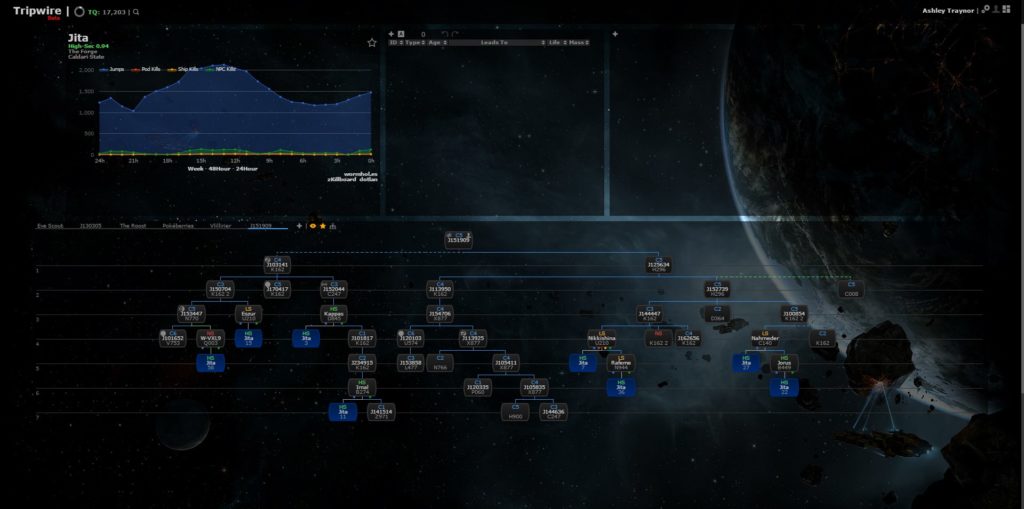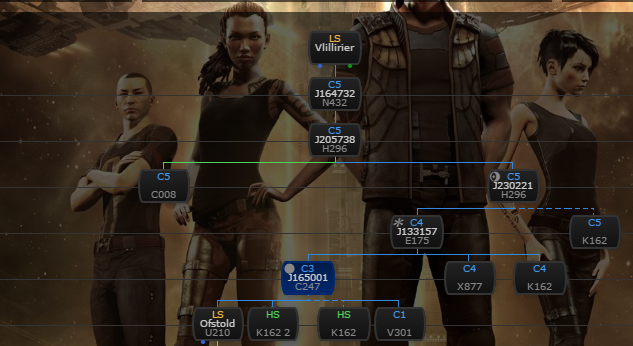Wormhole space sits at an interesting place in the Eve universe. En eerie void separated from any “normal” means of travel. The lack of stargates or jump networks is often the first major hurdle for
Cartography
Starting out with perhaps the most useful tool in a
If you’ve never used Tripwire before, you can think of it as similar to DOTLAN but with maps personally rebuilt by your corp/alliance each day. That might sound like hard work to someone accustomed to setting an autopilot route then clicking once per system on the yellow gate. In reality though, just having the knowledge of where everything is laid out gives you a great deal more intel than roaming blindly through connecting wormholes. Instead of asking your fleet to search through dozens of systems to find “J153447”, you can simply ask them to meet you at the “C5 N770 that’s three jumps from home”.
As well as making navigation easier, mapping tools integrate well with existing corp/alliance intel networks. Notes are typically displayed at a glance for those with access to read, useful for detailing who lives where and what to be aware of in a given system. Admins are also able to set up masks which will display the wormhole chain to select players of their choosing. It even automatically fills out for lazier corpmates those not scouting themselves!
Eyes
Of course, in order to use this mapping software, you actually need people to start scanning. Scouting is absolutely paramount to groups operating successfully in and around wormhole space. Most residents will have a second account entirely for that function. Even if you’re a massive krab who never leaves his own hole unless there’s ISK involved, having a purpose-built character for scanning makes life just that much easier. Personally, I can count on one hand how many times I’ve said, “I am really enjoying scanning with low skills and no combat capability” (I haven’t). This is often useful since you never know when you may suddenly need a quick exit, a set of combat probes, or even just eyes on a new connection.
To be a successful scout you really do need to know your trade. In W-space, just watching Local and DOTLAN isn’t really an option. The chain that you’re using is a dynamically changing environment, so even if you’re sitting two jumps behind the fleet watching a hole, it’s entirely possible for a sig to spawn in a system that nobody is monitoring. This is the part where a hostile scout find you; this is also the part where a hostile fleet lands on you and nobody knows why because, “we had eyes up the chain right?”
Part of the scout’s job is to act as an extension of the FC, being proactive wherever possible and giving up-to-date reports on the the situation before it happens. A group of scouts should coordinate with each other and continually watch for sigs in mapped out systems. Additionally, considering the fact that Local isn’t really a thing to a wormholer, it’s worth always keeping an eye on D-scan and taking mental notes of what you’ve seen. If something changes then question it. Either go find out yourself or check on comms, “has that Tengu has always been there?…”
If you take anything away from this short section on scouting though, let it be the idea that scouts should be content-driven. By that I mean you aren’t just some brick of scanning modules floating about. You should be a provider of fun/content for yourself and the corp. In most cases that’s going to mean hunting wild krabs, finding other fleets to skirmish, or targets of opportunity to attack. Even the “pinchier” among us can still take on this mindset. Just go out and look for sites or ore belts…. whatever you krabs do…

Branching Out
Additionally, anyone can easily take these techniques and apply them to K-space living. You may be thinking, “but Ashy, I roam around and use DOTLAN for mapping. How can this help me?” Well what if I told you that with absolutely minimal effort in scanning each day, you can link quickly to another region for either a change in pace or just more targets to hunt. The solution here is to scan out a chain from your home system using your favourite mapping tool.
By scanning out like this, you’re essentially expanding your “playing area”. Rather than confining yourself to Placid, for example, you could spend a Saturday roaming Metropolis/Bleak Lands and still have reinforcements close at hand. In much the same way, scanning your territory can easily create a shortcut to hisec markets, to null ratting pockets, or wherever your little heart desires. If it were up to me, everyone would be doing this. Being able to move around so quickly to strange new areas is often an excellent conflict driver that makes day-to-day life just that bit more interesting.
FC I’m Scared
Jaunting through wormhole space in this way is not for everyone, though. I’ve come across several groups that have been terribly afraid to even utilise these tools for what they are. The best advice I have for that is to suck it up and don’t wait for your fun to come to you.



Be First to Comment